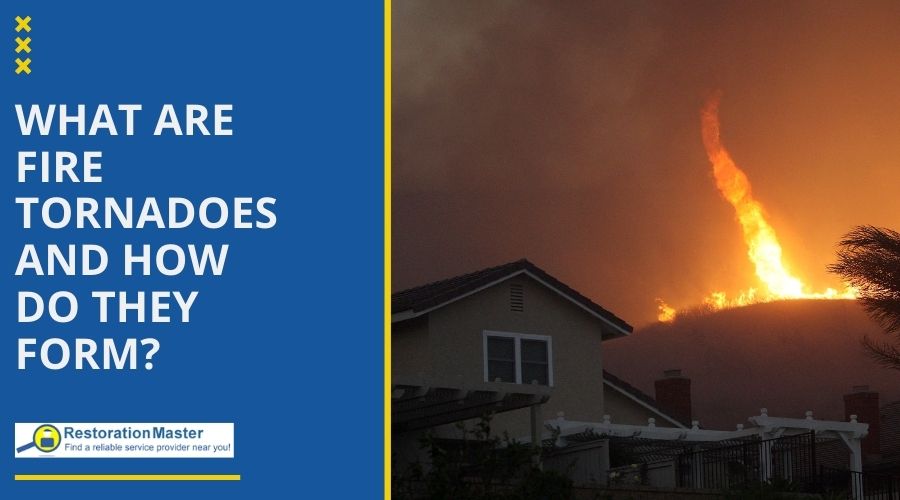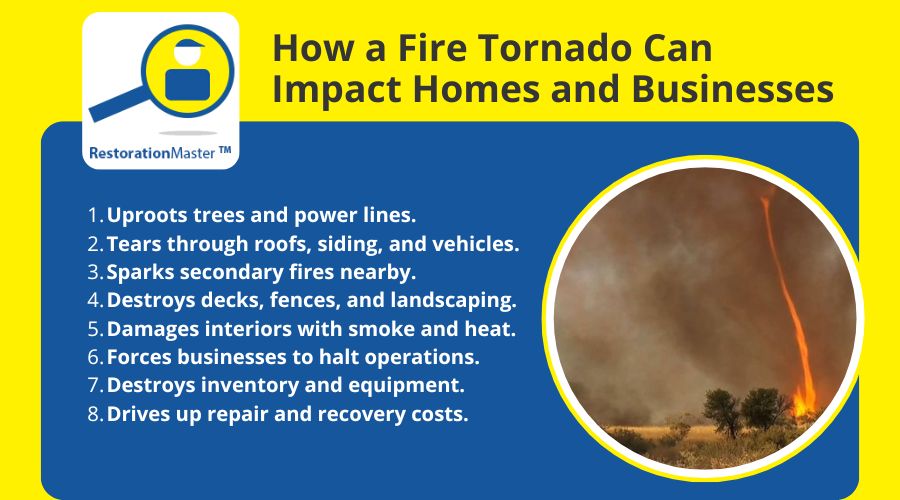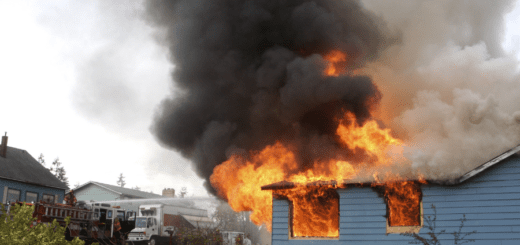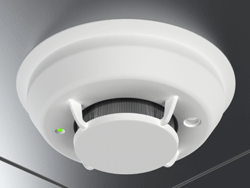What Are Fire Tornadoes and How Do They Form?

Wildfires are already destructive, but when extreme heat meets certain wind conditions, a rare and terrifying phenomenon can occur: fire tornadoes, also known as fire whirls, firenadoes, or fire devils. Unlike regular tornadoes, fire tornadoes are spinning columns of flames, smoke, and debris generated by intense wildfires. They combine the power of wind, heat, and rapidly rising air into a rotating vortex capable of causing significant damage.
How Do Fire Tornadoes Form?
Fire tornadoes form when extremely hot air from a wildfire rises rapidly, creating an updraft. If horizontal winds converge at the surface, they begin to rotate, forming a swirling vortex. When this rotating air combines with the fire’s heat, it can create a visible column of flames reaching up into the sky.
- Size and Speed: These fire whirls can range from just a few feet to more than 1,000 feet wide, with wind speeds sometimes exceeding 90 mph. In extreme cases, such as the 2018 Carr Fire in California, a fire tornado reached 143 mph, equivalent to an EF-3 tornado.
- Duration: Fire tornadoes are usually short-lived, often lasting only a few minutes, but their destructive potential is immense.
Are Fire Tornadoes Becoming More Common?
While fire tornadoes are still rare, climate change is making them more likely. Rising temperatures, prolonged droughts, and stronger, more erratic winds create conditions favorable for extreme wildfires—and for fire tornadoes. To better understand the origins of these fires, check out How Do Wildfires Start?
- Drier vegetation burns more easily, increasing fire intensity.
- Strong wind patterns can induce rotation, producing fire whirls.
- Expanding human settlements in fire-prone areas increase the potential for property damage.
According to the EPA, the number of large wildfires in the U.S. has increased significantly over the past two decades, with Western states like California, Oregon, and Utah experiencing some of the most severe wildfire behavior.
What Are the Recent Fire Tornadoes?
Fire tornadoes, while rare, have left a lasting mark in recent wildfire history:
- Carr Fire, California (2018): During this devastating fire, a fire tornado formed with winds reaching an astonishing 143 mph. It uprooted trees, leveled homes, and tragically claimed lives, highlighting just how destructive these fiery vortices can be.
- Loyalton Fire, California (2020): This fire made history when the National Weather Service issued its first-ever tornado warning specifically for a fire whirl. The event underscored the unpredictable and dangerous nature of fire tornadoes.
- Deer Creek Fire, Utah (2025): In Utah, a fire tornado ripped through parts of a neighborhood with winds of 122 mph, leaving behind extensive property damage and a stark reminder of the power these phenomena can unleash.
These events demonstrate that although fire tornadoes don’t occur frequently, when they do, their impact can be sudden and catastrophic, particularly in regions already vulnerable to wildfires.
The Science Behind Fire Tornadoes
Fire tornadoes don’t just appear randomly—they require a precise set of conditions:
- Temperature Gradients: Hot air from wildfires rises quickly, while nearby cooler air helps generate strong updrafts.
- Topography: Valleys, hills, and uneven terrain can funnel winds, increasing the chance of rotation.
- Wind Shear: Differences in wind speed or direction at various altitudes can spin the rising air into a vortex.
Even though they are brief, the intensity of fire tornadoes can rival mid-strength EF-scale tornadoes.
Fire Tornado Intensity vs. EF-Scale Tornadoes
| Fire Tornado Example | Wind Speed | EF-Scale Equivalent |
|---|---|---|
| Carr Fire, California (2018) | 143 mph | EF-3 |
| Deer Creek Fire, Utah (2025) | 122 mph | EF-2 |
| Typical Small Fire Whirl | 40–60 mph | EF-0 to EF-1 (small-scale) |
How Can You Prepare for Fire Tornadoes?
Fire tornadoes can appear suddenly, often during active wildfires, which makes direct preparationPreparation is the steps taken to ready a property, equipmen... More challenging. However, there are steps you can take to reduce risk and better protect your home and family:
- Create defensible space: Keep areas around your home clear of dry brush, dead leaves, and other flammable materials to help slow the spread of fire.
- Use fire-resistant materials: Consider roofing, siding, and decking materials designed to withstand flames, giving your home added protection.
- Plan your evacuation: Make sure every family member knows the safest routes and has a clear plan in case you need to leave quickly.
- Stay informed: Monitor local fire updates, weather alerts, and guidance from your fire department to stay ahead of any emerging threats.
While no plan can completely eliminate the risk, taking these steps can greatly improve your safety and give you more control in the face of these unpredictable events.
Fire Tornado Myths and Facts
Because fire tornadoes are so dramatic, they are often misunderstood. Here are some common misconceptions:
| Myth | Fact |
|---|---|
| Fire tornadoes are just regular tornadoes made of fire. | They are not true tornadoes in the meteorological sense—they do not extend from the cloud base to the ground. They are spinning columns of air and flames created by intense heat. |
| Every wildfire can create a fire tornado. | Small fire whirls are fairly common in wildfires, especially in grasslands and forests, but most are minor and rarely destructive. Only under the right combination of heat, wind, and terrain do they become dangerous fire tornadoes. |
| Fire tornadoes last for a long time. | Most fire tornadoes are short-lived, lasting only minutes, though their impact during that brief period can be severe. |
How a Fire Tornado Can Impact Homes and Businesses
Even though fire tornadoes are often short-lived, their destructive power can be staggering for both residential and commercial properties. A sudden vortex of flames and high-speed winds can:
- Uproot trees and power lines, tearing through roofs, siding, and vehicles.
- Ignite secondary fires that spread rapidly to nearby buildings.
- Destroy landscaping, decks, fences, and other outdoor structures.
- Damage interiors with smoke and heat, making homes or offices unsafe to inhabit.
For business owners, the consequences can be especially severe. Operations may be forced to pause for days or weeks, inventory can be destroyed, and repairRepair is the act of fixing or restoring damaged property, m... More costs can escalate quickly.

Call Fire Damage Restoration Experts from RestorationMaster
If your home or business suffers damage from a wildfire or fire tornado, timely professional assistance can make all the difference. RestorationMaster provides expert fire damage restoration services, including assessing and documenting damage for insurance claims, removing debris, sootSoot is fine black particles composed of carbon and other ma... More, and smoke from affected areas, restoring structural elements and personal property safely, and preventing further damage through mitigation and cleanup.
With a team of experienced fire restoration specialists, RestorationMaster can help you recover efficiently and safely after even the most severe fire events. Prompt intervention can save time, reduce costs, and prevent long-term damage.
Frequently Asked Questions
Do fire tornadoes occur only during wildfires?
Yes. Fire tornadoes require intense heat from a wildfire or large uncontrolled fire combined with strong winds. They cannot form without a significant fire source to generate rising hot air and flames.
Can fire tornadoes start other fires?
Yes. Fire tornadoes can throw burning debris over long distances, igniting secondary fires. This makes them particularly dangerous, as they can spread flames rapidly to nearby homes, businesses, and vegetation.
Can I safely observe a fire tornado?
No. Fire tornadoes are extremely dangerous and can change direction rapidly. Being even a short distance away is unsafe. The safest action is to evacuate the area immediately and follow official guidance.
How do fire tornadoes affect air quality?
Fire tornadoes release dense smoke and fine particulate matter into the air, worsening local air quality. These particles can cause respiratory issues, eye irritation, and long-term health effects for residents nearby.
Have fire tornadoes occurred outside the U.S.?
Yes. Fire tornadoes have been documented in wildfire-prone regions such as Australia and Canada. They form under similar conditions of extreme heat, strong winds, and dry vegetation.












